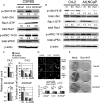Activation of Rac1 is closely related to androgen-independent cell proliferation of prostate cancer cells both in vitro and in vivo
- PMID: 20203103
- PMCID: PMC5417531
- DOI: 10.1210/me.2009-0326
Activation of Rac1 is closely related to androgen-independent cell proliferation of prostate cancer cells both in vitro and in vivo
Abstract
We and others previously showed that signaling through cSrc or atypical protein kinase C (aPKC) pathway regulates the proliferation of prostate cancer cells and is associated with their progression to castrate-resistance in vivo. However, the interrelation of these two kinases has been largely unexplored. In the present study, we show that androgen-induced activation of cSrc regulates the activity of aPKC through the small molecular weight G protein Rac1 in androgen-dependent LNCaP cells. Knockdown of cSrc in those cells reduces the phosphorylation of aPKC and the abundance of activated form of Rac1. Additionally, the treatment of those cells with Rac1 inhibitor repressed cell cycle progression at G(1)/S transition. In fact, forced expression of a constitutively active Rac1 mutant in LNCaP cells promoted cell proliferation under androgen-depleted conditions both in vitro and in vivo. Moreover, LNCaP C4-2 and AILNCaP cells, the syngeneic androgen-independent sublines from LNCaP cells, harbored abundant Rac1-GTP. Importantly, the inhibition of Rac1 suppressed cell proliferation and induced apoptotic cell death in all prostate cancer cell lines tested irrespective of their androgen-dependence. In immunohistochemical evaluation of tumor specimens from prostate cancer patients, Rac1 pathway appeared to be activated in the majority of castrate-resistant diseases. Collectively, our present results both in vitro and in vivo highly implicate that Rac1 can be a potential therapeutic target for patients with advanced prostate cancer, especially those with castrate-resistant status.
Figures






Similar articles
-
Signal transduction pathways in androgen-dependent and -independent prostate cancer cell proliferation.Endocr Relat Cancer. 2005 Mar;12(1):119-34. doi: 10.1677/erc.1.00835. Endocr Relat Cancer. 2005. PMID: 15788644
-
Deregulation of the Rho GTPase, Rac1, suppresses cyclin-dependent kinase inhibitor p21(CIP1) levels in androgen-independent human prostate cancer cells.Oncogene. 2004 Jul 15;23(32):5513-22. doi: 10.1038/sj.onc.1207708. Oncogene. 2004. PMID: 15077174
-
A Signaling Network Controlling Androgenic Repression of c-Fos Protein in Prostate Adenocarcinoma Cells.J Biol Chem. 2016 Mar 11;291(11):5512-5526. doi: 10.1074/jbc.M115.694877. Epub 2016 Jan 19. J Biol Chem. 2016. PMID: 26786102 Free PMC article.
-
Changes in androgen receptor nongenotropic signaling correlate with transition of LNCaP cells to androgen independence.Cancer Res. 2004 Oct 1;64(19):7156-68. doi: 10.1158/0008-5472.CAN-04-1121. Cancer Res. 2004. PMID: 15466214
-
Progression of LNCaP prostate tumor cells during androgen deprivation: hormone-independent growth, repression of proliferation by androgen, and role for p27Kip1 in androgen-induced cell cycle arrest.Mol Endocrinol. 1998 Jul;12(7):941-53. doi: 10.1210/mend.12.7.0136. Mol Endocrinol. 1998. PMID: 9658399
Cited by
-
Regulation of onco and tumor suppressor MiRNAs by mTORC1 inhibitor PRP-1 in human chondrosarcoma.Tumour Biol. 2014 Mar;35(3):2335-41. doi: 10.1007/s13277-013-1309-7. Epub 2013 Nov 1. Tumour Biol. 2014. PMID: 24178909
-
Androgen deprivation‑induced OPHN1 amplification promotes castration‑resistant prostate cancer.Oncol Rep. 2022 Jan;47(1):3. doi: 10.3892/or.2021.8214. Epub 2021 Nov 5. Oncol Rep. 2022. PMID: 34738630 Free PMC article.
-
IRS-2 deubiquitination by USP9X maintains anchorage-independent cell growth via Erk1/2 activation in prostate carcinoma cell line.Oncotarget. 2018 Sep 21;9(74):33871-33883. doi: 10.18632/oncotarget.26049. eCollection 2018 Sep 21. Oncotarget. 2018. PMID: 30338032 Free PMC article.
-
Comprehensive genomics in androgen receptor-dependent castration-resistant prostate cancer identifies an adaptation pathway mediated by opioid receptor kappa 1.Commun Biol. 2022 Apr 1;5(1):299. doi: 10.1038/s42003-022-03227-w. Commun Biol. 2022. PMID: 35365763 Free PMC article.
-
Role of MicroRNAs in Treatment Response in Prostate Cancer.Curr Cancer Drug Targets. 2018;18(10):929-944. doi: 10.2174/1568009618666180315160125. Curr Cancer Drug Targets. 2018. PMID: 29644941 Free PMC article. Review.
References
-
- Ferlay J, Bray F, Pisani P, Parkin D2001. Globocan 2000: cancer incidence, mortality and prevalence worldwide. Version 1.0. Lyon, France: IARC Press
-
- Jemal A, Siegel R, Ward E, Murray T, Xu J, Smigal C, Thun MJ2006. Cancer statistics, 2006. CA-Cancer J Clin 56:106–130 - PubMed
-
- Huggins C, Hodges CV1941. Studies on prostatic cancer: I. The effect of castration, of estrogen and of androgen injection on serum phosphatases in metastatic carcinoma of the prostate. Cancer Res 1:293–297 - PubMed
-
- Heinlein CA, Chang C2004. Androgen receptor in prostate cancer. Endocr Rev 25:276–308 - PubMed
-
- Unni E, Sun S, Nan B, McPhaul MJ, Cheskis B, Mancini MA, Marcelli M2004. Changes in androgen receptor nongenotropic signaling correlate with transition of LNCaP cells to androgen independence. Cancer Res 64:7156–7168 - PubMed
Publication types
MeSH terms
Substances
LinkOut - more resources
Full Text Sources
Other Literature Sources
Medical
Research Materials
Miscellaneous

